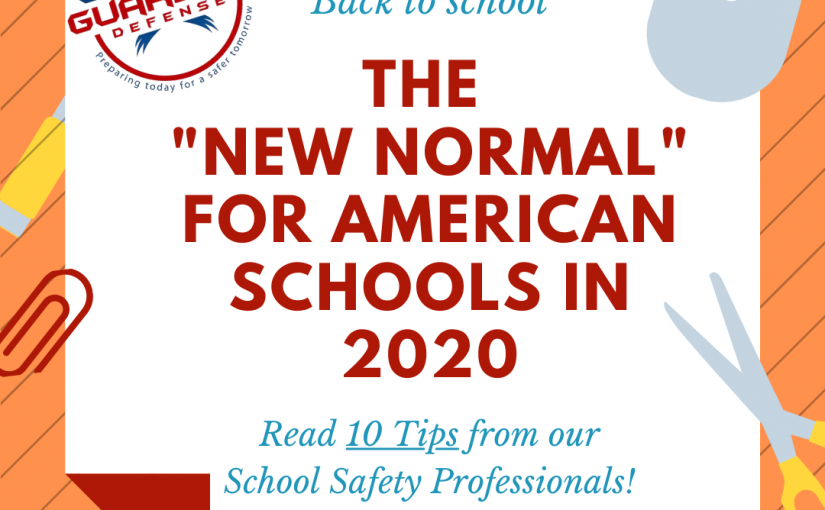2020 has been an unexpected year for everyone around the globe. For months, companies and individuals placed great effort into staying safe and learning to adapt to our new reality: the age of Coronavirus, riots, civil unrest, and other vulnerabilities.
Back to School Safety in the Age of Coronavirus, Riots, Civil Unrest and Other Vulnerabilities
Luckily, these efforts have not been in vain. Although many American schools, especially public, will not open for face to face instruction this Fall, there is a good percentage of schools that have taken the leap to accept the challenge of in-person learning during a pandemic. Challenges so delicate and intricate like the silk on a spider web. These efforts come with a great deal of responsibility to stay safe and healthy for all involved parties.
Why is Safety in Schools Important?
Does Your School Have the Right Safety Rules?
5 Back to School Safety Tips Every School, Teacher, and Parent Needs to Know About

Back to School Safety Tip #1
Do not allow COVID-19 be the only focus in reference to safety. Address and plan for all types of emergencies. When one potential emergency is weighted as the greatest threat, the school or organization becomes vulnerable in other areas.
Back to School Safety Tip #2
If a school does not have a safety response team, create one. Avoid complacency in other areas during the COVID-19 pandemic. Schedule a meeting with the school’s safety response team and review their preparations for all potential emergencies.
Back to School Safety Tip #3
Review existing safety plans and policies for the year and ensure all are up to date. Disseminate the plans for faculty and staff to review.
Back to School Safety Tip #4
Create an emergency drill schedule and conduct drills monthly. This creates a continuum of learning and allows for inefficiencies to be fixed.
Back to School Safety Tip #5
Assess your annual training schedule. Identify any additional or refresher safety training needed while going through the first 4 tips and then fulfill the training needs.
How Does the State of Today’s World Affect Student’s Mental Health & Well-Being?

Unfortunately, youth stress, anxiety, depression, and suicide were at an all-time high before the pandemic and current civil unrest. Experts agree that a spike in these conditions during and after this crisis will occur.
To say that this will impact learning environments as kids return back to school is an understatement. We have an already distressed student population returning to our campuses after extended periods of social isolation, under possible family and economic stressors, having had major shifts in routine, and with possible exposure to abuse or other poor home environmental factors.
A Look at Pre-pandemic Youth Mental Health

Source: National Alliance on Mental Illness
Where there is instability in mental health, there is the potential for a crisis. Mental health cannot be ignored when addressing a strategic plan for the safety of students and staff.
5 Back to School Mental Health Reflections Every School Leader Needs to Consider in Student Re-Acclimation
Back to School Mental Health Consideration #1
Just as every student is different, each family circumstance is different. Be aware that home environments across your student body are likely varied. While some students may have experienced the positive side of quarantine, others may have had an environment of isolation, abuse, hunger, financial hardship, etc.
Back to School Mental Health Consideration #2
Everyone responds to change and stress differently. Things are changing day-to-day, and there is a lot we do not know, and cannot control. Students are behind academically, and staff curriculum plans are in flux as we teeter between in-person and virtual learning. Recognize that this is uncharted territory that can cause additional internal turmoil and external acting out.
Though there is no one-size-fits-all way to rid stress, anxiety, and depression due to circumstances, there are some great evidence-based methodologies that can help.
Back to School Mental Health Consideration #3
Consider what is guiding your student’s viewpoint? Is it the news, social media, statistics, pop-culture? Do they have a perception or perspective?
Seek to understand how they are interpreting what they are hearing and seeing. If it is from an unhealthy perspective, help them to see the world as it is and not as it is presented (i.e. social media isn’t a source for accurate portrayals of reality).
Back to School Mental Health Consideration #4
There is a lot of discord concerning the facts and what response there should be on both fronts, the pandemic and civil rights. You may be on the frontlines of arguments and disagreements in the very halls of your schools. This scenario isn’t isolated to students but can also impact staff. Seek to drive a culture of harmony and respect for differences that leaves room for disagreement without hostility.
Back to School Mental Health Consideration #5
Self-care is as vital to the well-being of others within your sphere of influence, as it is to yourself. You must first take care of yourself before you can be effective in caring for others. With so many depending upon you during this time (students, parents, administrators, government officials), have you put your mental and emotional well-being on the back-burner?
Take a moment each day to calm your mind, reflect on the day, and focus on what YOU can change. In the end, YOU have control of how YOU will respond to challenges. YOU can create a safe mental outlook for yourself, and in turn, be a guide for others.

